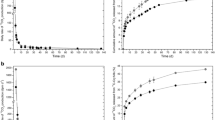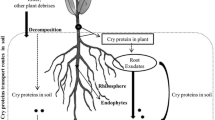Abstract
The environmental impact of genetically modified crops has been the subject of intense research in the past decade. Since the introduction of insect-resistant crops in 1996, cultivation of this group of genetically modified crops has grown substantially. Most insect-resistant varieties, including corn and cotton, have been engineered to express crystal (Cry) toxins. Although several studies concerning the environmental fate of this group of insecticidal toxins have been conducted during the past decade, conflicting information exists dealing with the persistence of Cry toxins in soil. In the present investigation, the persistence of antilepidopteran Cry1Ab and Cry1Ac toxins in two different agricultural soils was studied. The potential of cry1Ab genes to persist in soil was also estimated. The results from this laboratory investigation indicated that the two toxins dissipated rapidly in both the sandy and in the clay loam soil. The two toxins showed similar degradation rates in soil. During the 35-day incubation period, more than 92 and 79% of the initial amount of Cry toxins dissipated in the sandy and clay loam soil, respectively. Extractable fractions of the two toxins were lower in the fine-textured soil with respect to the coarse soil. Reduced recovery efficiency from the clay loam soil and thus bioavailability were presumably involved in the lower decline of Cry toxins in this soil. Investigations conducted with an insect-resistant transgenic corn hybrid showed no detectable levels of cry1Ab genes in soil six months after plant harvest.
Similar content being viewed by others
References
Accinelli C., Koskinen W.C., Sadowsky M.J. (2006) Influence of Cry1Ac toxin on mineralization and bioavailability of glyphosate in soil, J. Agr. Food Chem. 54, 164–169.
Blackwood C.B., Buyer J.S. (2004) Soil microbial communities associated with Bt and non-Bt corn in three soils, J. Environ. Qual. 33, 832–836.
Cerón J., Ortíz A., Quintero R., Güereca L., Bravo A. (1995) Specific PCR primers directed to identify cryI and cryIII genes within a Bacillus thuringiensis strain collection, Appl. Environ. Microb. 61, 3826–3831.
Clark B.W., Phillips T.A., Coats J.R. (2005) Environmental fate and effects of Bacillus thuringiensis (Bt) proteins from transgenic crops: a review, J. Agr. Food Chem. 53, 4643–4653.
Devare M.H., Jones C.M., Thies J.E. (2004) Effect of Cry3Bb transgenic corn and tefluthrin on the soil microbial community: biomass, activity, and diversity, J. Environ. Qual. 33, 837–843.
Donegan K.K., Palm C.J., Fieland V.J., Porteus L.A., Ganio L.M., Schaller D.L., Bucao L.Q., Seidler R.J. (1995) Changes in levels, species, and DNA fingerprints of soil microorganisms associated with cotton expressing the Bacillus thuringiensis var. kurstaki endotoxin, Appl. Soil Ecol. 2, 111–124.
Dunfield K.E., Germida J.J. (2004) Impact of genetically modified crops on soil- and plant-associated microbial communities, J. Environ. Qual. 33, 806–815.
Franchi M., Bramanti E., Bonzi L.M., Orioli P.L., Vettori C., Gallori E. (1999) Clay-nucleic acid complexes: characteristics and implications for the preservation of genetic material in primeval habitats, Origins Life Evol. B. 29, 297–315.
Head G., Surber J.B., Watson J.A., Martin J.W., Duan J. (2002) No detection of Cry1Ac protein in soil after multiple years of transgenic Bt cotton (Bollgard) use, Environ. Entomol. 31, 30–36.
Hendriksen N.B., Hansen B.M. (2002) Long-term survival and germination of Bacillus thuringiensis var kurstaki in a field trial, Can. J. Microbiol. 48, 256–261.
Herman R.A., Evans S.L., Shanahan D.M., Mihaliak C.A., Bormett G.A., Young D.L., Buehrer J. (2001) Rapid degradation of Cry1F delta-endotoxin in soil, Environ. Entomol. 30, 642–644.
Herman R.A., Scherer P.N., Wolt J.D. (2002) Rapid degradation of a binary, PS149B1, δ-endotoxin of Bacillus thuringiensis in soil, and a novel mathematical model for fitting curve-linear decay, Environ. Entomol. 31, 208–214.
James C. (2005) Global Status of Commercialized Transgenic Crops. ISAAA Brief 34, ISAAA, Ithaca, NY.
Mohd-Salleh M.B., Lewis L.C. (1982) Toxic effects of spore/crystal ratios of Bacillus thuringiensis on European corn borer larvae, J. Invertebr. Pathol. 39, 290–297.
Motovalli P.P., Kremer R.J., Fang M., Means N.E. (2004) Impact of genetically modified crops and their management on soil microbially mediated plant nutrient transformations, J. Environ. Qual. 33, 816–824.
Nuñez-Valdez M.E., Sànchez J., Lina L., Güereca L., Bravo A. (2001) Structural and functional studies of α-helix 5 region from Bacillus thuringiensis Cry1Ab δ-endotoxin, Biochem. Biophys. Acta 156, 122–131.
Palm C.J., Donegan H., Harris D., Seidler R.J. (1994) Quantification in soil of Bacillus thuringiensis var kurstaki δ-endotoxin from transgenic plants, Mol. Ecol. 3, 145–151.
Palm C.J., Schaller D.L., Donegan K.K., Seidler R.J. (1996) Persistence in soil of transgenic plant produced Bacillus thuringiensis var. kurstaki δ-endotoxin, Can. J. Microbiol. 42, 1258–1262.
Park H.W., Bideshi D.K., Federici B.A. (2000) Molecular genetic manipulation of truncated Cry1C protein synthesis in Bacillus thuringiensis to improve stability and yield, Appl. Environ. Microbiol. 66, 4449–4455.
Petras S.F., Casida L.E. Jr. (1985) Survival of Bacillus thuringiensis spores in the soil, Appl. Environ. Microb. 50, 1496–1501.
Saxena D., Flores S., Stotzky G. (2002) Vertical movement in soil of insecticidal Cry1Ab protein from Bacillus thuringiensis, Soil Biol. Biochem. 34, 111–120.
Shan G., Embrey S.K., Herman R.A., Wolt J.D., Weston D., Mayer L.M. (2005) Biomimetic extraction of Bacillus thuringiensis insecticidal crystal proteins from soil based on invertebrate gut fluid chemistry, J. Agr. Food Chem. 53, 6630–6634.
Sims S.R., Holden L.R. (1996) Insect bioassay for determining soil degradation of Bacillus thuringiensis subsp. kurstaki Cry1A(b) protein in corn tissue, Environ. Entomol. 25, 659–664.
Stotzky G. (2000) Persistence and biological activity in soil of insecticidal proteins from Bacillus thuringiensis and of bacterial DNA bound on clays and humic acids, J. Environ. Qual. 29, 691–705.
Tapp H., Stotzky G. (1998) Persistence of the insecticidal toxin from Bacillus thuringiensis subsp. kurstaki from soil, Soil Biol. Biochem. 4, 471–476.
Travers R.S., Martin P.A.W, Reichelderfer C.F. (1987) Selective process for efficient isolation of soil Bacillus spp., Appl. Environ. Microb. 53, 1263–1266.
Venkateswerlu G., Stotzky G. (1992) Binding of the protoxin and toxin proteins of Bacillus thuringiensis subsp. kurstaki on clay minerals, Curr. Microbiol. 25, 225–233.
West A.W, Burges H.D., White R.J., Wyborn C.H. (1984) Persistence of Bacillus thuringiensis parasporal crystal insecticidal activity in soil, J. Invertebr. Pathol. 44, 128–133.
Widmer F., Seidler R.J., Watrud L.S. (1996) Sensitive detection of transgenic plant marker gene persistence in soil microcosms, Mol. Ecol. 5, 603–613.
Author information
Authors and Affiliations
Corresponding author
About this article
Cite this article
Marchetti, E., Accinelli, C., Talamè, V. et al. Persistence of Cry toxins and cry genes from genetically modified plants in two agricultural soils. Agron. Sustain. Dev. 27, 231–236 (2007). https://doi.org/10.1051/agro:2007010
Accepted:
Issue Date:
DOI: https://doi.org/10.1051/agro:2007010




